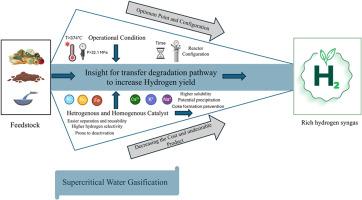A comprehensive review on degradation pathways, catalyst screening and machine learning in supercritical water gasification from biomass for sustainable hydrogen production
IF 5.8
2区 生物学
Q1 AGRICULTURAL ENGINEERING
引用次数: 0
Abstract
Supercritical water gasification (SCWG) efficiently converts biomass into hydrogen-rich syngas. This review analyzes biomass degradation pathways, process parameters, reactor configurations, and catalytic advancements to enhance hydrogen selectivity and carbon gasification efficiency. Biomass components (cellulose, hemicellulose, lignin, lipids, proteins) undergo hydrolysis, decarboxylation, dehydration, and reforming to produce H2, CO, CO2, and CH4. Key operational parameters (temperature, pressure, feed concentration, residence time) are evaluated to optimize syngas yield and minimize energy use. Reactor designs (batch, fluidized bed, continuous systems) are compared for scalability and efficiency. Catalytic enhancements involve homogeneous catalysts (KOH, Na2CO3) and heterogeneous catalysts (Ni, Co, Fe, Ru, Pt), focusing on synthesis methods to improve catalyst performance. Catalysts influence Water Gas Shift (WGS), methanation, steam reforming, and bond cleavage under supercritical conditions. Na and K promote biomass decomposition via formate intermediates; Ca enhances CO2 capture and reforming; Ni facilitates H2-selective bond activation; Ru aids organic breakdown; Fe, Ce, Cu, and Co support gasification. Furthermore, application strategies that affect dispersion, scalability, and regeneration potential. Alongside regeneration techniques like oxidative purging, steam stripping, solvent washing, calcination, and in situ rejuvenation, deactivation mechanisms are covered. Additionally, advancements in machine learning (ML) applied to SCWG include models like artificial neural networks (ANNs), support vector machines (SVMs), Random Forests (RF), and Gradient Boosting Regressors (GBR), successfully predicting hydrogen yield, syngas composition, and optimizing process parameters. Finally, end-product and waste stream management are addressed, covering gaseous, liquid, and solid residues, with effective mitigation strategies outlined for each stream.

生物质超临界水气化可持续制氢的降解途径、催化剂筛选和机器学习综述
超临界水气化(SCWG)有效地将生物质转化为富氢合成气。本文分析了生物质降解途径、工艺参数、反应器配置以及提高氢选择性和碳气化效率的催化进展。生物质组分(纤维素、半纤维素、木质素、脂质、蛋白质)经过水解、脱羧、脱水和重整产生H2、CO、CO2和CH4。对关键操作参数(温度、压力、饲料浓度、停留时间)进行评估,以优化合成气产量并最大限度地减少能源消耗。反应器设计(间歇式,流化床,连续系统)的可扩展性和效率进行比较。催化增强包括均相催化剂(KOH, Na2CO3)和非均相催化剂(Ni, Co, Fe, Ru, Pt),重点是提高催化剂性能的合成方法。在超临界条件下,催化剂影响水气转换(WGS)、甲烷化、蒸汽重整和键解理。Na和K通过甲酸酯中间体促进生物质分解;Ca促进CO2的捕获和重整;Ni有利于h2选择性键活化;Ru有助于有机分解;Fe、Ce、Cu和Co支持气化。此外,影响分散性、可伸缩性和再生潜力的应用程序策略。除了氧化净化、蒸汽汽提、溶剂洗涤、煅烧和原位再生等再生技术外,还涵盖了失活机制。此外,应用于SCWG的机器学习(ML)的进步包括人工神经网络(ann)、支持向量机(svm)、随机森林(RF)和梯度增强回归(GBR)等模型,成功预测了氢气产量、合成气成分和优化工艺参数。最后,讨论了最终产品和废物流的管理,包括气体、液体和固体残留物,并为每种废物流概述了有效的缓解战略。
本文章由计算机程序翻译,如有差异,请以英文原文为准。
求助全文
约1分钟内获得全文
求助全文
来源期刊

Biomass & Bioenergy
工程技术-能源与燃料
CiteScore
11.50
自引率
3.30%
发文量
258
审稿时长
60 days
期刊介绍:
Biomass & Bioenergy is an international journal publishing original research papers and short communications, review articles and case studies on biological resources, chemical and biological processes, and biomass products for new renewable sources of energy and materials.
The scope of the journal extends to the environmental, management and economic aspects of biomass and bioenergy.
Key areas covered by the journal:
• Biomass: sources, energy crop production processes, genetic improvements, composition. Please note that research on these biomass subjects must be linked directly to bioenergy generation.
• Biological Residues: residues/rests from agricultural production, forestry and plantations (palm, sugar etc), processing industries, and municipal sources (MSW). Papers on the use of biomass residues through innovative processes/technological novelty and/or consideration of feedstock/system sustainability (or unsustainability) are welcomed. However waste treatment processes and pollution control or mitigation which are only tangentially related to bioenergy are not in the scope of the journal, as they are more suited to publications in the environmental arena. Papers that describe conventional waste streams (ie well described in existing literature) that do not empirically address ''new'' added value from the process are not suitable for submission to the journal.
• Bioenergy Processes: fermentations, thermochemical conversions, liquid and gaseous fuels, and petrochemical substitutes
• Bioenergy Utilization: direct combustion, gasification, electricity production, chemical processes, and by-product remediation
• Biomass and the Environment: carbon cycle, the net energy efficiency of bioenergy systems, assessment of sustainability, and biodiversity issues.
 求助内容:
求助内容: 应助结果提醒方式:
应助结果提醒方式:


